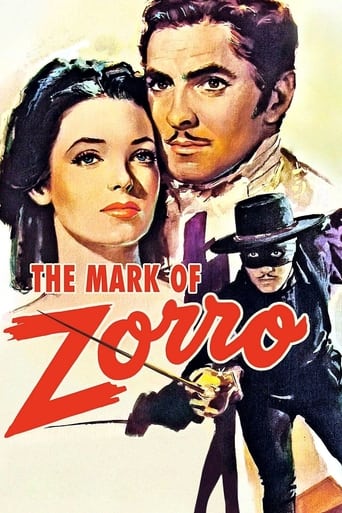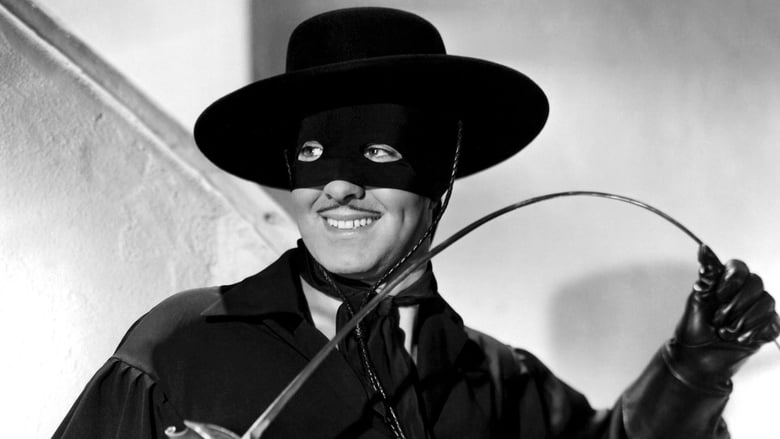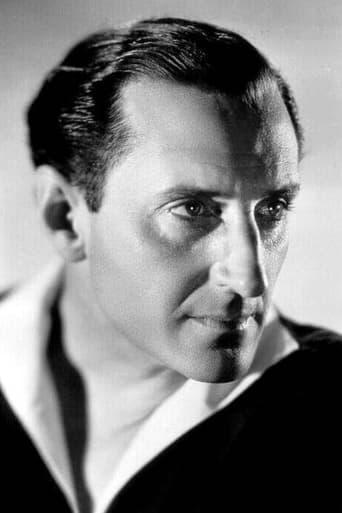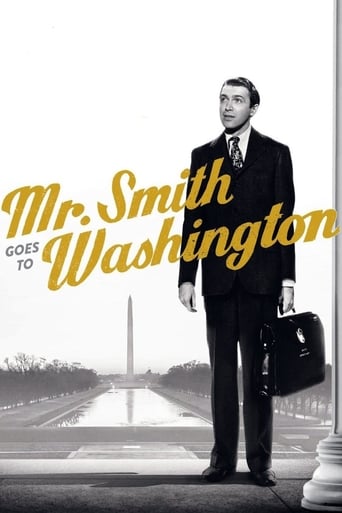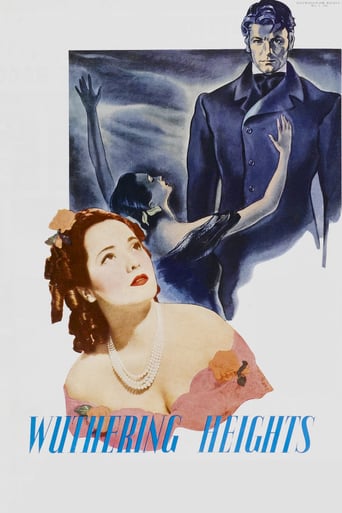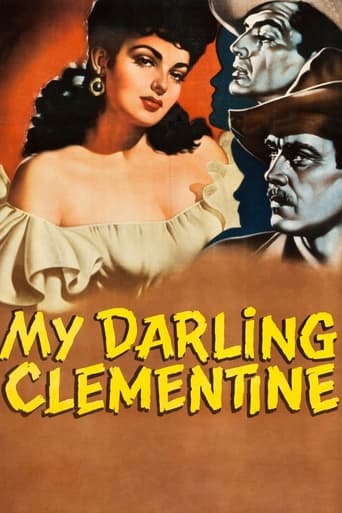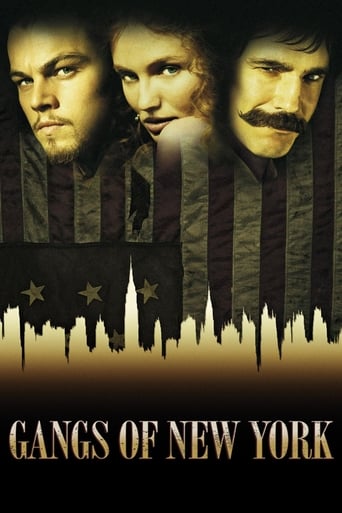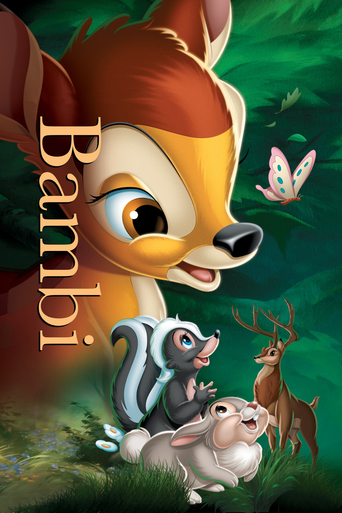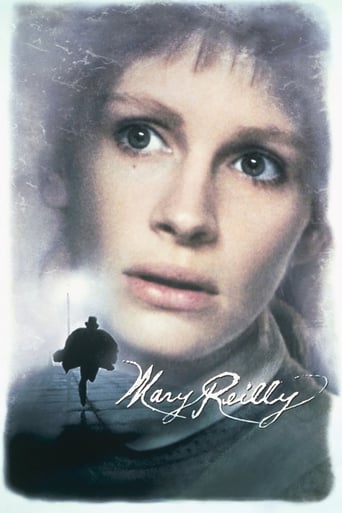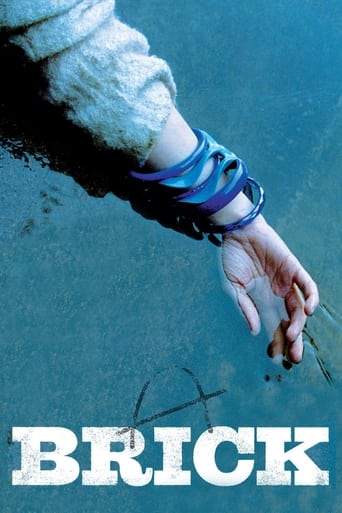The Mark of Zorro (1940)
Around 1820 the son of a California nobleman comes home from Spain to find his native land under a villainous dictatorship. On the one hand he plays the useless fop, while on the other he is the masked avenger Zorro.
Watch Trailer
Cast


Similar titles
Reviews
Don't listen to the Hype. It's awful
Although it has its amusing moments, in eneral the plot does not convince.
If the ambition is to provide two hours of instantly forgettable, popcorn-munching escapism, it succeeds.
It's easily one of the freshest, sharpest and most enjoyable films of this year.
My first introduction to the character Zorro was in an old serial they showed on television in the early 1950s when I just a kid, to wit, "Zorro's Fighting Legion" (1939). Needless to say, I was fascinated by the parts where Zorro was all decked out in his black outfit, complete with cape, sword, and whip. The television station followed up by presenting an earlier serial, "Zorro Rides Again" (1937), and though I didn't care for his mask, I still paid more attention to the parts where he was in costume and not so much to the parts where he is in ordinary dress pretending to be weak and lazy. And I was thrilled when Disney studios produced a television series entitled simply "Zorro" in 1957. As before, it was the parts where I got to see Zorro gallivanting about that I was interested in, not so much the part where he is Don Diego de la Vega.Whether I preferred the parts where Zorro is doing stuff was because I was a child or whether it was because these two serials and the television series were juvenile in nature, I cannot say. But it was quite a surprise for me when, as a college student, I saw "The Mark of Zorro" for the first time. Of course, it had the star quality of such actors as Tyrone Power and Basil Rathbone, as well as the production values of a major studio, all of which were bound to make it much better than what I had seen previously. But what really struck me was the fact that the parts of the movie featuring Zorro constituted a relatively small amount of screen time, which was greatly exceeded by the amount of time devoted to Don Diego. The emphasis on Don Diego in this movie even went so far as to have him fight the climactic duel as Diego and not as Zorro. In this, the movie followed the 1920 version with Douglas Fairbanks. But most movies do not do this, choosing instead to have the climactic duel fought by Zorro. For example, the made-for-television version starring Frank Langella has the actor in full Zorro regalia in the final showdown.The amount of screen time given to Zorro versus Diego determines the kind of movie it is. A costumed character is exciting to watch, but he is all action and external appearance. He must be in constant motion, running, riding, fighting, and so forth. If he stands still for too long, he begins to look silly, especially if he is wearing a cape. It is with his secret identity, Diego in the case of Zorro movies, that we get to know the man, to learn what he thinks and feels. Moreover, we get to watch him acting a part in order to keep people from suspecting that he is the one who wears the mask. In this case, the part is that of a fop. It is a pretense also used in "The Scarlet Pimpernel" (1934), starring Leslie Howard as the title character and as Sir Percy Blakeney, but Howard's performance in that role was over the top and irritating. Diego's foppery as performed by Tyrone Power, on the other hand, is so good that we find ourselves impatiently waiting for the Zorro scenes to end so that we can have more Diego.
It's 1820 and Tyrone Power (Diego) is summoned back from his military training in Spain. His father Montagu Love (Alejandro) has sent for him and so he arrives back in Los Angeles, which is basically a town of Mexicans. Overseeing the territory is J Edward Bromberg (Quintero) who keeps the tax money for himself and shares it with his bodyguard Basil Rathbone (Captain Pasquale). These guys are bad, especially Rathbone, and his wife Gale Sondergaard (Inez) is super scheming. What can Tyrone do to help the people ? Well, Zorro shows up ..This is good entertainment and Power is very good in the lead role. As Diego, he is wonderfully camp as he complains of his bath water being tepid amongst other things. There is no way this guy can fight. Well, Rathbone learns different in a memorable fencing sequence towards the end of the film. Power also has a couple of good scenes with Linda Darnell (Lolita), eg, in the chapel when she comes across Zorro disguised as a priest but doesn't realize who he is. There is an amusing bit where she repeatedly bends down to try and look at his face but he is wise to this and bends down with her. The cast is rounded off with Eugene Palette as the likable Padre and George Regas as the nasty Gonzales.As coincidence would have it, I came across the Antonio Banderas version of Zorro in the evening on TV after I had watched this version in the afternoon. As far as I can see, no comparison. The 1940 version wins. Watch out for a crazy stunt as Zorro and horse jump off a bridge into a river – woah!
One thing this movie has is impressive horse riding chase scenes that make you grin at the ingenuity of the director and the cinematographer. The films pace is so exciting that you know that you just have to dip your hat to how it was captured on celluloid. Basil Rathbone (who is famous for playing Sherlock Holmes in the Rathbone/Bruce series that contained 14 movies between the years of 1939 – 1946) is a famous Hollywood swordsman, and I also read that Tyrone Power was also good with sword, and so I eagerly waited for the duel scene between the two.When the duel started, the idea that this was actually both the actors willing the swords and not just mere stunt men also added to the fun, as the duel is just wonderful and masterful, the grace and the speed the two masterful swordsmen displayed on screen is one that I will always remember, and one that I ask others to see, because I have not seen better fencing than that as of now.The movie had scenes that jumped at you, there was another chase scene where Zorro (Tyrone Power) made his horse jump off a bridge into a stream and made the horse ride/swam to shore, it was such a sight I raised my brow in amazement, wondering how many shots the director had to take to get that scene right.The Mark of Zorro is fun, although you can pick out plot holes and wonder how the hero was planning to achieve anything in the riot like ending, but the movie was fun to see all the way through, the story arc is taken from the story The Curse of Capistrano written by Johnston McCulley in 1919, the book introduced the masked hero Zorro, who was like Robin Hood in most sense. Set in Southern California during the early 19th century, the plot deals with Don Diego Vega/Zorro (Tyrone Power), who returned home to find that his town is being extorted by the Governor and his henchman Captain Esteban Pasquale (Basil Rathbone).Diego then became the mask vigilante Zorro to be able to able to defend his people from the hand of the corrupt Governor.The Mark of Zorro is a true oldie; the score is so obvious and doesn't blend with the movie (from my own point of view) although the score did get an Academy Award nomination.The Mark of Zorro is one you can take the time to see even if it is just to see the duel between Power and Rathbone.www.lagsreviews.com
"The Mark of Zorro" was clearly 20 Century Fox's answer to the spectacular success of Warner Brothers' "The Adventures of Robin Hood". Many of the same elements are present, including a swashbuckling outlaw hero fighting against the ruthless and greedy forces of oppression while winning a beautiful and virtuous heroine. They even managed to engage many of the same supporting cast; including Eugene Palette reprising his role of the hero's priest-friend, Basil Rathbone as a sword-wielding villain, and Montague Love (as a good guy this time). Rathbone, in particular, stands out in one of his most effective portrayals in a long series of classic villains, one every bit as memorable as the one he portrayed in Robin Hood. The plot itself is a re-do of the classic 1920 silent film that cemented Douglas Fairbanks' reputation as an international film idol. With so much of The Mark of Zorro being a re-hash of elements that had been done before, it stands to reason that the production would have to have been carried off extremely well in order to have had any impact. In fact, it was done very well indeed. To star in a vehicle such as this you need an actor with great presence and charisma and, at that time, Tyrone Power had that in spades. He was clearly intended to be 20th Century Fox's answer to Errol Flynn, a role that he unquestionably pulled off, particularly in the period before the war (the Tyrone Power who returned from military service in the war was a far more mature actor, one less suited to the former swashbuckling roles). Power's Zorro is less athletic than Douglas Fairbanks' version, but then no actor, with the sole possible exception of Burt Lancaster, could ever hope to approach Fairbanks in that department. However, there is little dispute that Power was at his very best at the time he made The Mark of Zorro.Power's co-star, Linda Darnell, who was still only 17 years old, was just beginning the period of her best work when this film was made. Unfortunately, she was given little to do in this film, besides look beautiful (with which she had no trouble). It is also unfortunate for Darnell that she shared most of her scenes with one of the screen's finest character actresses, the much-unappreciated Gale Sondergaard. That is no aspersion on the talent of Darnell, because Sondergaard was fully capable of stealing scenes from the best scenery-chewers in the business, including the likes of Betty Davis and Claude Rains. For example, during the same period when Zorro was produced, Sondergaard was also featured in the cast of "The Letter", in which she memorably dominated a scene shared with no less an acting presence than Bette Davis, and did it without even uttering a single word of dialogue!A movie like the "The Mark of Zorro" wouldn't work unless all the elements, actors, sets, costumes, music score and direction, come together. In this particular case, everything came together perfectly.

